Mazda CX-9 (2022 year). Manual in english — page 3

Essential Safety Equipment
Child Restraint
Always remove the head restraint and
Always install the head restraint and adjust
install child-restraint system (except when
it to the appropriate position after
installing a backless booster seat)
removing the child-restraint system
(Second-row seat):
(Second-row seat):
Installing a child-restraint system without
Driving with the head restraint removed is
removing the head restraint is dangerous.
dangerous as impact to the occupant's
The child-restraint system cannot be
head cannot be prevented during
installed correctly which may result in
emergency braking or in a collision, which
death or injury to the child in a collision.
could result in a serious accident, injury or
Second-row
Tether strap
death.
outboard seat
Refer to Head Restraints on page 2-28.
Always route the tether straps to the sides
of the head restraint (Third-row seat):
Routing the tether straps on top of the
Forward
head restraint is dangerous. In a collision
the tether straps could slide off the head
restraint and loosen the child-restraint
system. The child-restraint system could
move which may result in death or injury to
the child.
Second-row
Tether strap
Tether strap
Third-row seat
center seat
Forward
Forward
Always attach the tether strap to the
▼ If You Must Use the Front Seat for
correct tether anchor position:
Children
Attaching the tether strap to the incorrect
If you cannot put all children in the rear
tether anchor position is dangerous. In a
seat, at least put the smallest children in
collision, the tether strap could come off
the rear and be sure the largest child up
and loosen the child-restraint system. If the
front uses the shoulder belt over the
child-restraint system moves it could result
shoulder.
in death or injury to the child.
2-59
Essential Safety Equipment
Child Restraint
NEVER put a rear-facing child-restraint
WARNING
system on the front passenger seat whether
your vehicle is equipped with an occupant
Always move the front passenger seat as
classification sensor or not.
far back as possible if installing a
This seat is also not set up for tethered
child-restraint systems, put them in one of
front-facing child-restraint system on it is
the rear seat positions set up with tether
unavoidable:
As your vehicle has front air bags and
anchors.
doubly so because your vehicle has side air
Likewise the ISOFIX/LATCH*1
bags, a front-facing child-restraint system
child-restraint system cannot be secured in
should be put on the front passenger seat
the front passenger's seat and should be
only when it is unavoidable.
used in the second-row seat.
Even if the front passenger air bag
Do not allow anyone to sleep against the
deactivation indicator light illuminates,
side window since your vehicle has side
always move the seat as far back as
and curtain air bags, it could cause serious
possible, because the force of a deploying
injuries to an out of position occupant. As
air bag could cause serious injury or death
children more often sleep in cars, it is
to the child.
better to put them in the rear seat. If
installing the child-restraint system on the
Never use a rear-facing child-restraint
front seat is unavoidable, follow these
system in the front seat with an air bag
instructions when using a front-facing
that could deploy:
child-restraint system in the front
Rear-facing child-restraint systems on the
passenger's seat.
front seat are particularly dangerous.
*1
ISOFIX (Mexico)/LATCH (Except
Even in a moderate collision, the
Mexico)
child-restraint system can be hit by a
NOTE
deploying air bag and moved violently
backward resulting in serious injury or
To check if your front seats have side air
death to the child. Even though you may
bags:
feel assured that the front passenger air
Mazda vehicles equipped with side air
bag will not deploy based on the fact that
bag will have a "SRS AIRBAG" tag on
the front passenger air bag deactivation
the outboard shoulder of the front seats.
indicator light illuminates, you should not
To check if your vehicle has curtain air
use a rear-facing child-restraint system in
bags:
the front seat.
Mazda vehicles equipped with curtain
air bag will have an "SRS AIRBAG"
marking on the window pillars along the
roof edge.
2-60
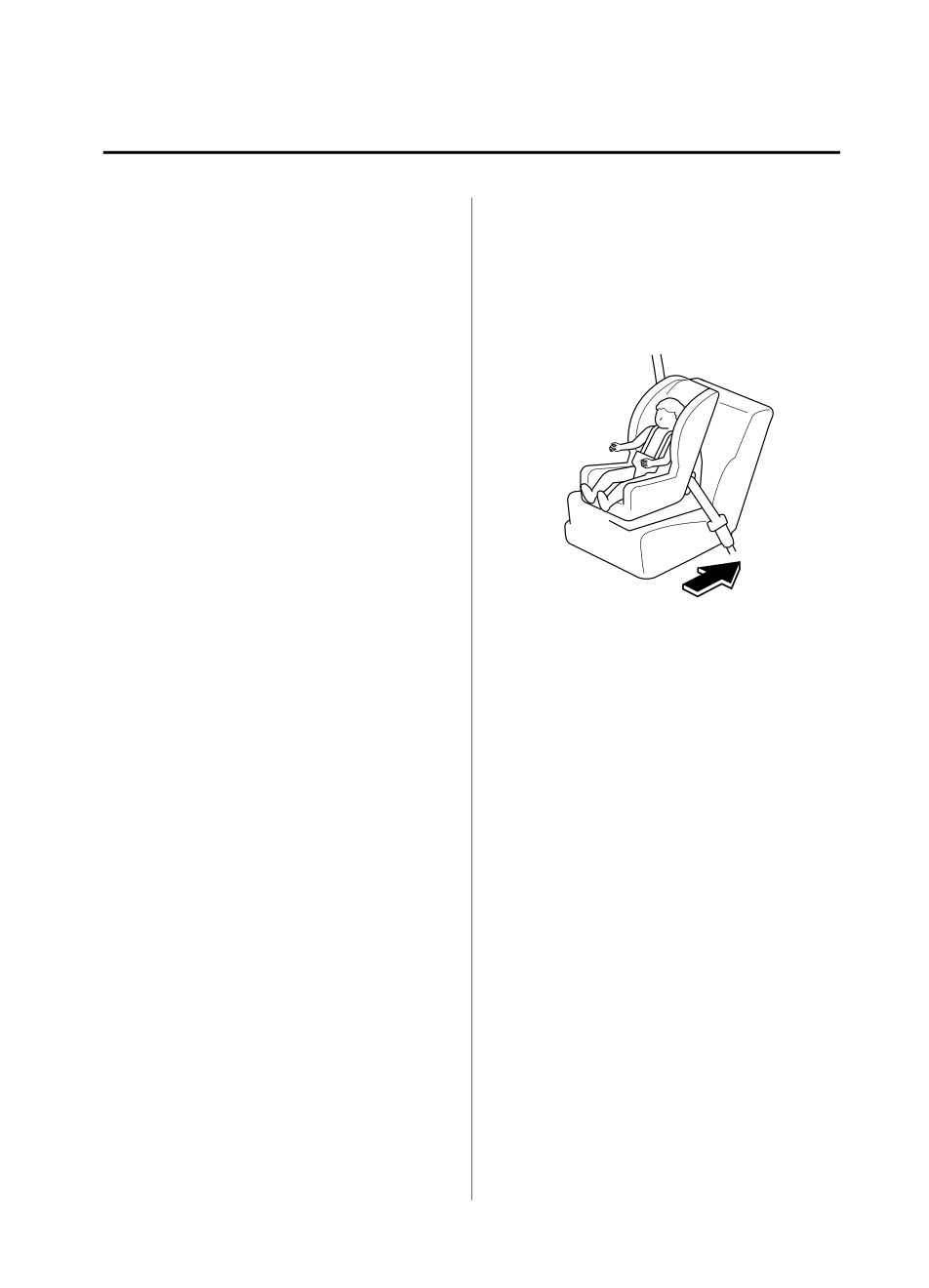
Essential Safety Equipment
Child Restraint
Do not allow a child or anyone to lean over
Front Passenger's Seat Child-Restraint
to or against the side window of a vehicle
System Installation (With Front
with side and curtain air bags:
Passenger Occupant Classification
It is dangerous to allow anyone to lean
System)
over to or against the side window, the
1.
Make sure the ignition is switched off.
area of the front passenger seat, the front
2.
Slide the seat as far back as possible.
and rear window pillars and the roof edge
along both sides from which the side and
curtain air bags deploy, even if a
child-restraint system is used. The impact
of inflation from a side or curtain air bag
could cause serious injury or death to an
out of position child. Furthermore, leaning
over to or against the door could block the
side and curtain air bags and eliminate the
advantages of supplemental protection.
Because the front seats are equipped with
front air bags, the rear seat is always a
3.
Remove the head restraint. However,
better location for children. Take special
when installing a backless booster seat,
care not to allow a child to lean over to or
always install the vehicle head restraint
against the side window, even if the child is
to the seat where the backless booster
seated in a child-restraint system.
seat is installed.
4.
Place the child-restraint system on the
Always remove the head restraint and
seat without putting your weight on the
install child-restraint system (except when
seat and fasten the seat belt. See the
installing a backless booster seat):
manufacturer's instructions on the
Installing a child-restraint system without
child-restraint system for belt routing
removing the head restraint is dangerous.
instructions.
The child-restraint system cannot be
5.
To get the retractor into the automatic
installed correctly which may result in
locking mode, pull the shoulder belt
death or injury to the child in a collision.
portion of the seat belt until the entire
length of the belt is out of the retractor.
Always install the head restraint and adjust
6.
Push the child-restraint system firmly
it to the appropriate position after
into the vehicle seat. Be sure the belt
removing the child-restraint system:
retracts as snugly as possible. A
Driving with the head restraint removed is
clicking noise from the retractor will
dangerous as impact to the occupant's
be heard during retraction if the system
head cannot be prevented during
is in automatic locking mode. If the
emergency braking or in a collision, which
belt does not lock the seat down tight,
could result in a serious accident, injury or
repeat the previous step and also this
death.
one.
Refer to Head Restraints on page 2-28.
2-61

Essential Safety Equipment
Child Restraint
NOTE
then re-install the child-restraint
system (page 2-85).
Inspect this function before each use
of the child-restraint system. You
should not be able to pull the
shoulder belt out of the retractor
while the system is in the automatic
locking mode. When you remove the
child-restraint system, be sure the
belt fully retracts to return the
system to emergency locking mode
before occupants use the seat belts.
Follow the child-restraint system
manufacturer's instructions
carefully.
Depending on the type of
child-restraint system, it may not
employ seat belts which are in
automatic locking mode.
7.
Seat your child safely in the
child-restraint system and secure the
child according to the instructions
from the child-restraint system
manufacturer.
8.
Switch the ignition ON and make sure
the front passenger air bag deactivation
indicator light illuminates after
installing a child-restraint system on
the front passenger seat.
If the front passenger air bag
deactivation indicator light does not
illuminate, remove the child-restraint
system, switch the ignition to OFF, and
2-62
Essential Safety Equipment
Child Restraint
WARNING
Do not seat a child in a child-restraint
system on the front passenger seat if the
front passenger air bag deactivation
indicator light does not illuminate:
While it is always better to install any
child-restraint system on the rear seat, it is
imperative that a child-restraint system
ONLY be used on the front passenger seat if
the deactivation indicator light illuminates
when the child is seated in the
child-restraint system (page 2-85). Seating
a child in a child-restraint system installed
on the front passenger seat with the front
passenger air bag deactivation indicator
light not illuminated is dangerous. If this
indicator light does not illuminate, this
means that the front passenger front and
side air bags, and seat belt pretensioners
are ready for deployment. If an accident
were to deploy an air bag, a child in a
child-restraint system sitting in the front
passenger seat could be seriously injured or
killed. If the indicator light does not
illuminate after seating a child in a
child-restraint system on the front
passenger seat, seat a child in a
child-restraint system on the rear seat and
consult an Authorized Mazda Dealer as
soon as possible.
2-63
Essential Safety Equipment
Child Restraint
▼ (Mexico) Using ISOFIX Lower Anchor (Second-row Seats)/(Except Mexico) Using
LATCH Lower Anchor (Second-row Seats)
Your Mazda is equipped with ISOFIX/LATCH*1 lower anchors for attachment of specially
designed ISOFIX/LATCH*1 child-restraint systems in the second-row seats. Both anchors
must be used, otherwise the seat will bounce around and put the child in danger. Most
ISOFIX/LATCH*1 child-restraint systems must also be used in conjunction with a tether to
be effective. If they have a tether you must use it to better assure your child's safety.
WARNING
Follow the manufacturer's instructions for the use of the child-restraint system:
An unsecured child-restraint system is dangerous. In a sudden stop or a collision it could move
causing serious injury or death to the child or other occupants. Make sure the child-restraint
system is properly secured in place according to the child-restraint system manufacturer's
instructions.
Never attach two child-restraint systems to the same ISOFIX/LATCH*1 lower anchor:
Attaching two child-restraint systems to the same ISOFIX/LATCH*1 lower anchor is dangerous.
In a collision, one anchor may not be strong enough to hold two child-restraint system
attachments, and it may break, causing serious injury or death. If you use the seat position for
another child-restraint system when an outboard ISOFIX/LATCH*1 position is occupied, use
the center seat belts instead, and the tether if tether-equipped.
Make sure the child-restraint system is properly secured:
An unsecured child-restraint system is dangerous. In a sudden stop or a collision it could move
causing serious injury or death to the child or other occupants. Follow the child-restraint
system manufacturer's instructions on belt routing to secure the seat just as you would with a
child in it so that nobody is tempted to put a child in an improperly secured seat later on.
When not in use, remove it from the vehicle or fasten it with a seat belt, or attach it to BOTH
ISOFIX/LATCH*1 lower anchors for ISOFIX/LATCH*1 child-restraint systems.
2-64
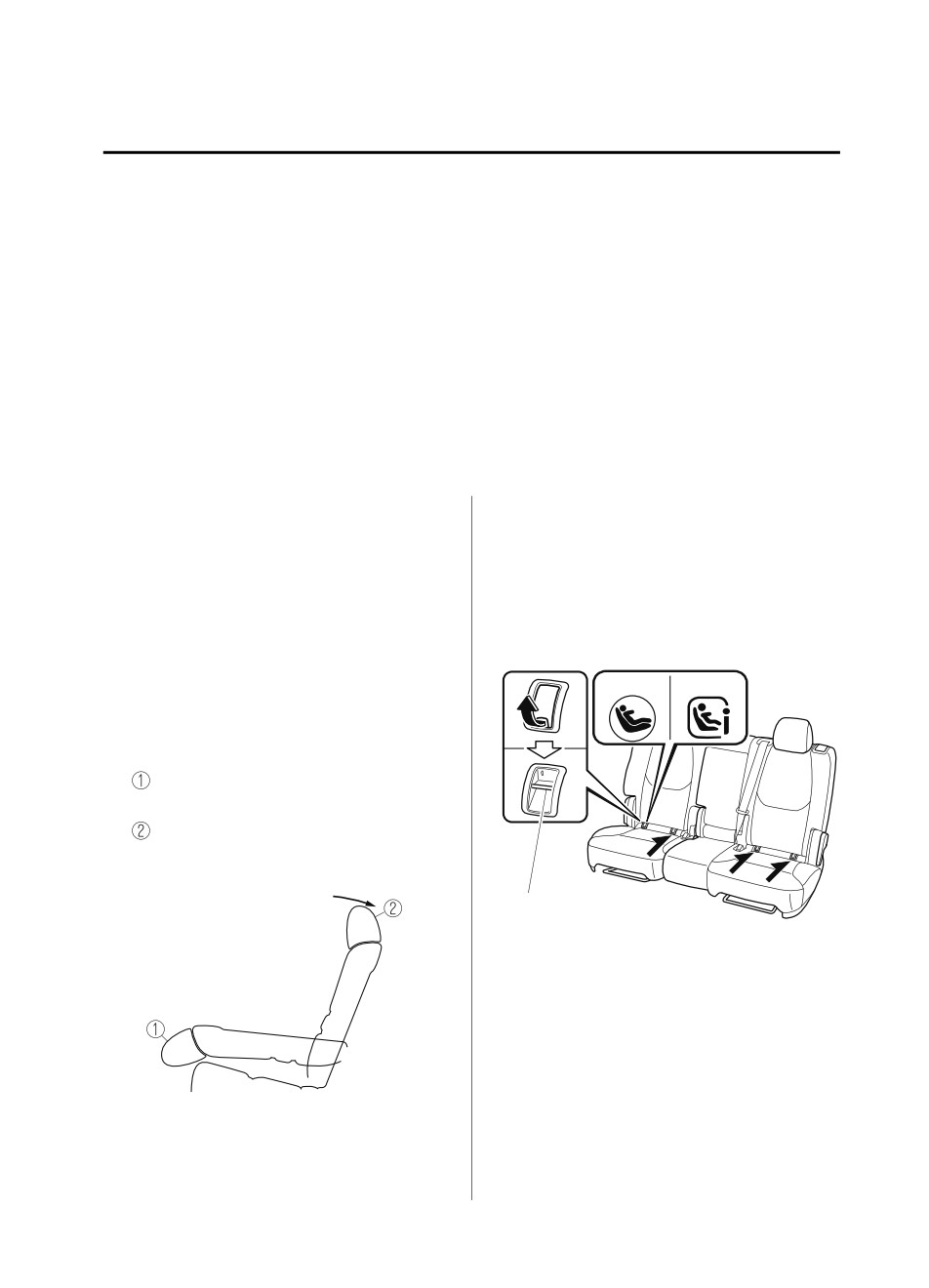
Essential Safety Equipment
Child Restraint
Make sure there are no seat belts or foreign objects near or around the ISOFIX/LATCH*1
child-restraint system:
Not following the child-restraint system manufacturer's instructions when installing the
child-restraint system is dangerous. If seat belts or a foreign object prevent the child-restraint
system from being securely attached to the ISOFIX/LATCH*1 lower anchors and the
child-restraint system is installed improperly, the child-restraint system could move in a
sudden stop or collision causing serious injury or death to the child or other occupants. When
installing the child-restraint system, make sure there are no seat belts or foreign objects near
or around the ISOFIX/LATCH*1 lower anchors. Always follow the child-restraint system
manufacturer's instructions.
*1
ISOFIX (Mexico)/LATCH (Except Mexico)
Installation on second-row outboard
4. Make sure the seatback is securely
seats
latched by pushing it back until it is
fully locked.
1.
First, adjust the front seat to allow
5. Remove the cover of the child-restraint
clearance between the child-restraint
system's ISOFIX/LATCH*1 lower
system and the front seat.
anchors to verify the locations of the
Refer to Adjusting the Driver's Seat on
ISOFIX/LATCH*1 lower anchors.
page 2-5.
Refer to Adjusting the Front
Type A
Type B
Passenger's Seat on page 2-13.
2.
Adjust the second-row seat position
using the following procedure.
Fold the second-row seatback
forward.
Raise the second-row seatback until
a click sound is heard and it is locked
in place.
Lower anchor
NOTE
The ISOFIX/LATCH*1 lower
anchors marking on the cover
indicates the position of the ISOFIX/
LATCH*1 lower anchors for the
attachment of a child-restraint
system.
3.
Adjust the angle of the second-row
Store the removed cover so that it
seatback so that there is no gap
does not get lost.
between the child-restraint system and
the second-row seatback.
2-65

Essential Safety Equipment
Child Restraint
6.
Remove the head restraint. However,
Installing a child-restraint system without
when installing a backless booster seat,
removing the head restraint is dangerous.
always install the vehicle head restraint
The child-restraint system cannot be
to the seat where the backless booster
installed correctly which may result in
seat is installed.
death or injury to the child in a collision.
Refer to Head Restraints on page 2-28.
Second-row
Tether strap
7.
Secure the child-restraint system using
center seat
BOTH ISOFIX/LATCH*1 lower
anchors, following the child-restraint
system manufacturer's instruction. Pull
on the child-restraint to be sure both
Forward
anchors are engaged.
8.
If your child-restraint system came
equipped with a tether, that means it is
very important to properly secure the
tether for child safety. Please carefully
follow the child-restraint system
Always attach the tether strap to the
manufacturer's instructions when
correct tether anchor position:
installing tethers.
Attaching the tether strap to the incorrect
*1
ISOFIX (Mexico)/LATCH (Except
tether anchor position is dangerous. In a
Mexico)
collision, the tether strap could come off
and loosen the child-restraint system. If the
WARNING
child-restraint system moves it could result
in death or injury to the child.
Use the tether and tether anchor only for a
child-restraint system:
Always install the head restraint and adjust
Using the tether or tether anchor to secure
it to the appropriate position after
anything but a child-restraint system is
removing the child-restraint system:
dangerous. This could weaken or damage
Driving with the head restraint removed is
the tether or tether anchor and result in
dangerous as impact to the occupant's
injury.
head cannot be prevented during
emergency braking or in a collision, which
Always remove the head restraint and
could result in a serious accident, injury or
install child-restraint system (except when
death.
installing a backless booster seat):
Refer to Head Restraints on page 2-28.
Installation on second-row center seat
The ISOFIX/LATCH*1 lower anchors at
the center of the second-row seat are much
2-66
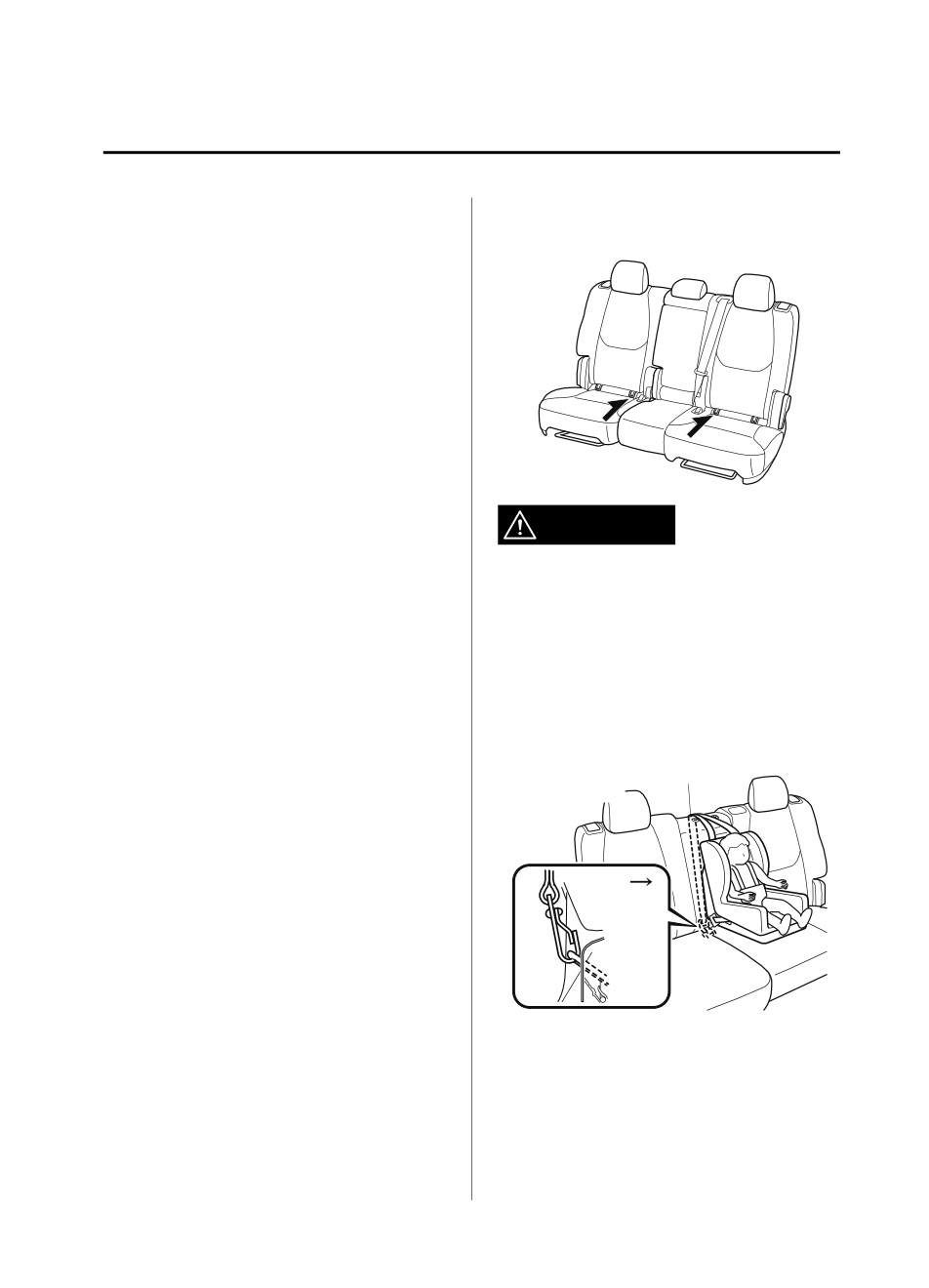
Essential Safety Equipment
Child Restraint
further apart than the sets of ISOFIX/
ISOFIX/LATCH*1 lower anchor
LATCH*1 lower anchors for child-restraint
location
system installation at other seating
positions. Child-restraint systems with
rigid ISOFIX/LATCH*1 attachments
cannot be installed on the center seating
position. Some ISOFIX/LATCH*1
equipped child-restraint systems can be
placed in the center position and will reach
the nearest ISOFIX/LATCH*1 lower
anchors which are 500 mm (19.7 in) apart.
ISOFIX/LATCH*1 compatible
child-restraint systems (with attachments
on belt webbing) can be used at this
WARNING
seating position only if the child-restraint
system manufacturer's instructions state
Always remove the head restraint and
that the child-restraint system can be
install child-restraint system (except when
installed to ISOFIX/LATCH*1 lower
installing a backless booster seat):
anchors that are 500 mm (19.7 in) apart.
Installing a child-restraint system without
Do not attach two child-restraint systems
removing the head restraint is dangerous.
to the same ISOFIX/LATCH*1 lower
The child-restraint system cannot be
anchor. If your child-restraint system has a
installed correctly which may result in
tether, it must also be used for your child's
death or injury to the child in a collision.
optimum safety.
Second-row
Tether strap
center seat
The procedure for installation on the rear
outboard seats is the same.
*1
ISOFIX (Mexico)/LATCH (Except
Mexico)
Forward
2-67
Essential Safety Equipment
Child Restraint
Always attach the tether strap to the
correct tether anchor position:
Attaching the tether strap to the incorrect
tether anchor position is dangerous. In a
collision, the tether strap could come off
and loosen the child-restraint system. If the
child-restraint system moves it could result
in death or injury to the child.
Always install the head restraint and adjust
it to the appropriate position after
removing the child-restraint system:
Driving with the head restraint removed is
dangerous as impact to the occupant's
head cannot be prevented during
emergency braking or in a collision, which
could result in a serious accident, injury or
death.
Refer to Head Restraints on page 2-28.
*1
ISOFIX (Mexico)/LATCH (Except
Mexico)
2-68
Essential Safety Equipment
SRS Air Bags
Supplemental Restraint System (SRS) Precautions
The front and side supplemental restraint systems (SRS) include different types of air bags.
Please verify the different types of air bags which are equipped on your vehicle by
locating the “SRS AIRBAG” location indicators. These indicators are visible in the area
where the air bags are installed.
The air bags are installed in the following locations:
The steering wheel hub (driver air bag)
The front passenger dashboard (front passenger air bag)
The outboard sides of the front seatbacks (side air bags)
The front and rear window pillars, and the roof edge along both sides (curtain air bags)
Vehicles with the Front Passenger Occupant Classification System have a sensor which
detects an impending roll-over accident.
The air bag supplemental restraint systems are designed to provide supplemental protection
in certain situations so seat belts are always important in the following ways:
Without seat belt usage, the air bags cannot provide adequate protection during an accident.
Seat belt usage is necessary to:
Keep the occupant from being thrown into an inflating air bag.
Reduce the possibility of injuries during an accident that is not designed for air bag
inflation, such as rear impact.
Reduce the possibility of injuries in frontal, near frontal or side collisions or roll-over
accidents that are not severe enough to activate the air bags.
Reduce the possibility of being thrown from your vehicle.
Reduce the possibility of injuries to lower body and legs during an accident because the
air bags provide no protection to these parts of the body.
2-69
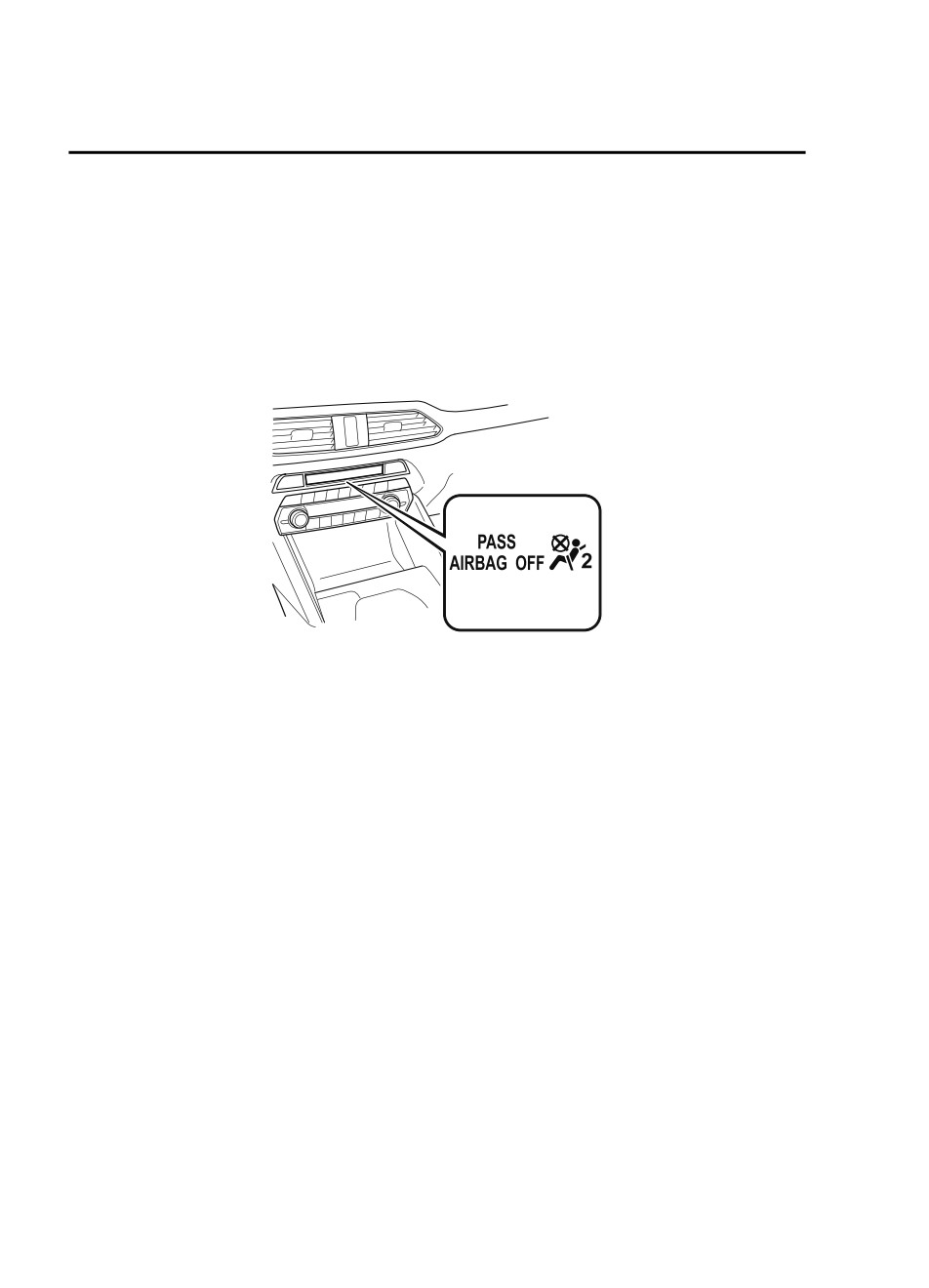
Essential Safety Equipment
SRS Air Bags
Hold the driver in a position which allows better control of the vehicle.
If your vehicle is also equipped with a front passenger occupant classification system,
refer to the Front Passenger Occupant Classification System (page 2-85) for details.
If your vehicle is equipped with a front passenger occupant classification system, the front
passenger air bag deactivation indicator light illuminates for a specified time after the
ignition is switched ON.
Small children must be protected by a child-restraint system as stipulated by law in every
state and province. In certain states and provinces, larger children must use a child-restraint
system (page 2-44).
Carefully consider which child-restraint system is necessary for your child and follow the
installation directions in this Owner's Manual as well as the child-restraint system
manufacturer's instructions.
2-70
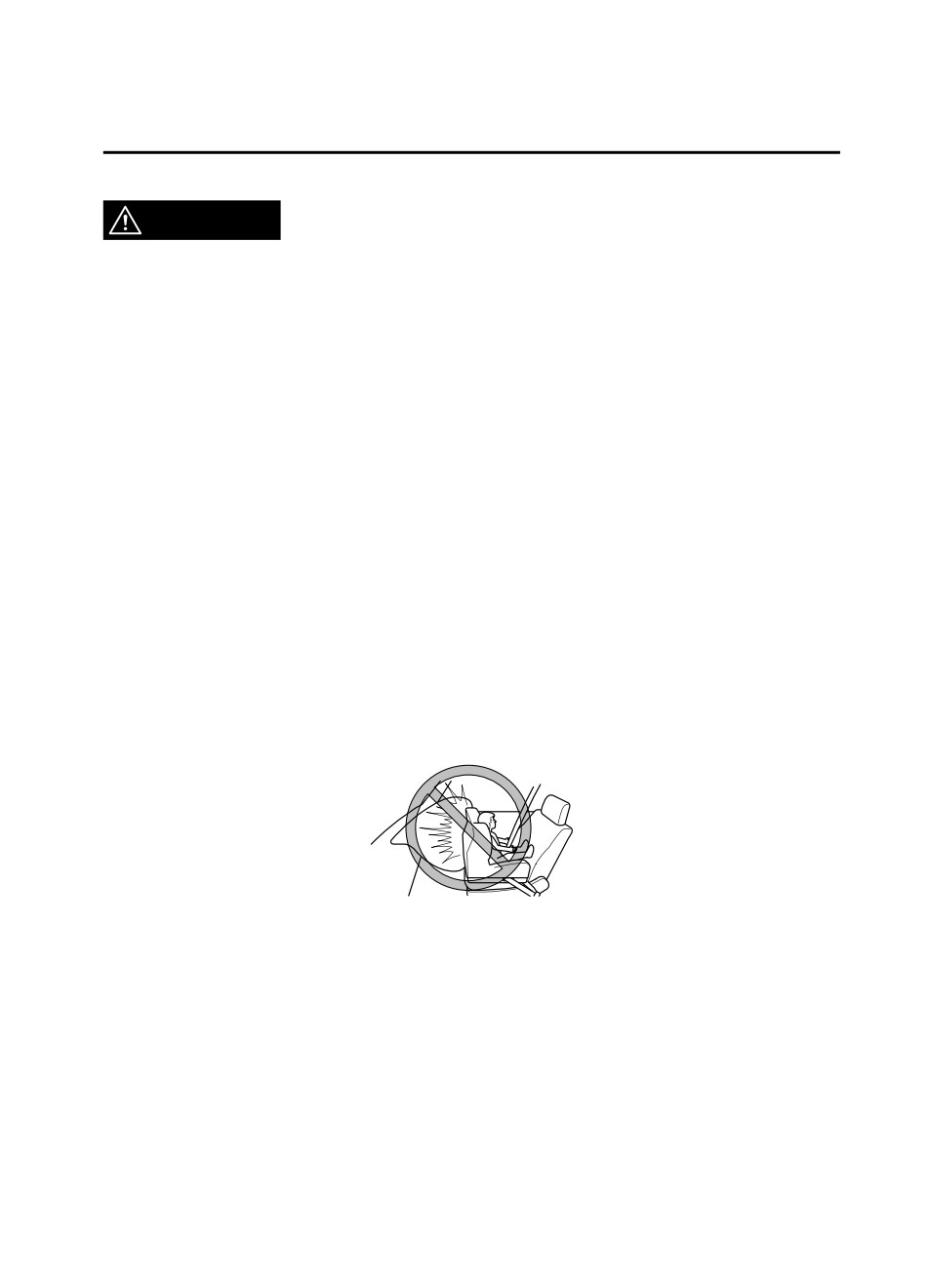
Essential Safety Equipment
SRS Air Bags
WARNING
Seat belts must be worn in air bag equipped vehicles:
Depending only on the air bags for protection during an accident is dangerous. Alone, air
bags may not prevent serious injuries. The appropriate air bags can be expected to inflate
only in the first accident, such as frontal, near frontal or side collisions or roll-over accidents
that are at least moderate. Vehicle occupants should always wear seat belts.
Children should not ride in the front passenger seat:
Placing a child, 12 years or under, in the front seat is dangerous. The child could be hit by a
deploying air bag and be seriously injured or even killed. A sleeping child is more likely to lean
against the door and be hit by the side air bag in moderate collision to the front-passenger
side of the vehicle. Whenever possible, always secure a child 12 years and under on the rear
seats with an appropriate child-restraint system for the child's age and size.
Never use a rear-facing child-restraint system in the front seat with an air bag that could
deploy:
Rear-facing child-restraint systems on the front seat are particularly dangerous even though
you may feel assured that a front passenger air bag will not deploy based on the fact that the
front passenger air bag deactivation indicator light illuminates. The child-restraint system
can be hit by a deploying air bag and moved violently backward resulting in serious injury or
death to the child.
Do not sit too close to the driver and front passenger air bags:
Sitting too close to the driver and front passenger air bag modules or placing hands or feet on
them is extremely dangerous. The driver and front passenger air bags inflate with great force
and speed. Serious injuries could occur if someone is too close. The driver should always hold
onto only the rim of the steering wheel. The front seat passenger should keep both feet on the
floor. Front seat occupants should adjust their seats as far back as possible and always sit
upright against the seatbacks with seat belts worn properly.
2-71
Essential Safety Equipment
SRS Air Bags
Sit in the center of the seat and wear seat belts properly:
Sitting too close to the side air bag modules or placing hands on them, or sleeping up against
the door or hanging out the windows is extremely dangerous. The side and curtain air bags
inflate with great force and speed directly expanding along the door on the side the car is hit.
Serious injury could occur if someone is sitting too close to the door or leaning against a
window, or if rear seat occupants grab the sides of the front seatbacks. Give the side and
curtain air bags room to work by sitting in the center of the seat while the vehicle is moving
with seat belts worn properly.
Do not attach objects on or around the area where air bags deploy:
Attaching objects to the air bags or placing something in the area where the air bags deploy
is dangerous. In an accident, an object could interfere with air bag inflation and injure the
occupants. Furthermore, the bag could be damaged causing gases to release. Always keep
the deployment area of the air bag modules free of any obstructions.
For example, you should not do any of the following as it may interfere with air bag
deployment.
¾ Do not put a covering on or lean anything against areas such as the dashboard and lower
portion of the instrument panel that blocks the passenger front air bag and knee air bags.
¾ Do not use seat covers on the front seats and rear seats equipped with in-seat side air bags.
¾ Do not hang any backpacks, bags or pouches that cover the sides of the seats that block the
side air bags.
¾ Do not place any objects on the assist grips. Only hang clothes directly on the coat hooks.
Do not touch the components of the supplemental restraint system after the air bags have
inflated:
Touching the components of the supplemental restraint system after the air bags have
inflated is dangerous. Immediately after inflation, they are very hot. You could get burned.
2-72
Essential Safety Equipment
SRS Air Bags
Never install any front-end equipment to your vehicle:
Installation of front-end equipment, such as frontal protection bar (kangaroo bar, bull bar,
push bar, or other similar devices), snowplow, or winches, is dangerous. The air bag crash
sensor system could be affected. This could cause air bags to inflate unexpectedly, or it could
prevent the air bags from inflating during an accident. Front occupants could be seriously
injured.
Do not modify the suspension:
Modifying the vehicle suspension is dangerous. If the vehicle's height or the suspension is
modified, the vehicle will be unable to accurately detect a collision or roll-over accident
resulting in incorrect or unexpected air bag deployment and the possibility of serious injuries.
To prevent false detection by the air bag sensor system, heed the following:
¾ Do not use tires or wheels other than those specified for your Mazda:
Use of any tire or wheel other than those specified for your Mazda (page 9-7) is
dangerous. Use of such wheels will prevent the vehicle's accident detections system from
accurately detecting a collision or roll-over accident resulting in incorrect or unexpected air
bag deployment and the possibility of serious injuries.
¾ Do not overload your vehicle:
Overloading your vehicle is dangerous as it could prevent the air bag crash sensor system
from accurately detecting a collision or roll-over accident resulting in incorrect or
unexpected air bag deployment and the possibility of serious injuries. The gross axle weight
rating (GAWR) and the gross vehicle weight rating (GVWR) for your vehicle are on the Motor
Vehicle Safety Standard Label on the driver's door frame. Do not exceed these ratings.
2-73
Essential Safety Equipment
SRS Air Bags
Do not modify a front door or leave any damage unrepaired. Always have an Authorized
Mazda Dealer inspect a damaged front door:
Modifying a front door or leaving any damage unrepaired is dangerous. Each front door has a
side crash sensor as a component of the supplemental restraint system. If holes are drilled in a
front door, a door speaker is left removed, or a damaged door is left unrepaired, the sensor
could be adversely affected causing it to not detect the pressure of an impact correctly during
a side collision. If a sensor does not detect a side impact correctly, the side and curtain air
bags and the front seat belt pretensioner may not operate normally which could result in
serious injury to occupants.
Do not modify the supplemental restraint system:
Modifying the components or wiring of the supplemental restraint system is dangerous. You
could accidentally activate it or make it inoperable. Do not make any modifications to the
supplemental restraint system. This includes installing trim, badges, or anything else over the
air bag modules. It also includes installing extra electrical equipment on or near system
components or wiring. An Authorized Mazda Dealer can provide the special care needed in
the removal and installation of front seats. It is important to protect the air bag wiring and
connections to assure that the bags do not accidentally deploy, and that the front passenger
occupant classification system and the seats retain an undamaged air bag connection.
Do not place luggage or other objects under the front seats:
Placing luggage or other objects under the front seats is dangerous. The components
essential to the supplemental restraint system could be damaged, and in the event of a side
collision, the appropriate air bags may not deploy, which could result in death or serious
injury. To prevent damage to the components essential to the supplemental restraint system,
do not place luggage or other objects under the front seats.
Do not operate a vehicle with damaged air bag/seat belt pretensioner system components:
Expended or damaged air bag/seat belt pretensioner system components must be replaced
after any collision which caused them to deploy or damage them. Only a trained Authorized
Mazda Dealer can fully evaluate these systems to see that they will work in any subsequent
accident. Driving with an expended or damaged air bag or pretensioner unit will not afford
you the necessary protection in the event of any subsequent accident which could result in
serious injury or death.
Do not remove interior air bag parts:
Removing any components such as the front seats, front dashboard, the steering wheel or
parts on the front and rear window pillars and along the roof edge, containing air bag parts
or sensors is dangerous. These parts contain essential air bag components. The air bag could
accidentally activate and cause serious injuries. Always have an Authorized Mazda Dealer
remove these parts.
2-74
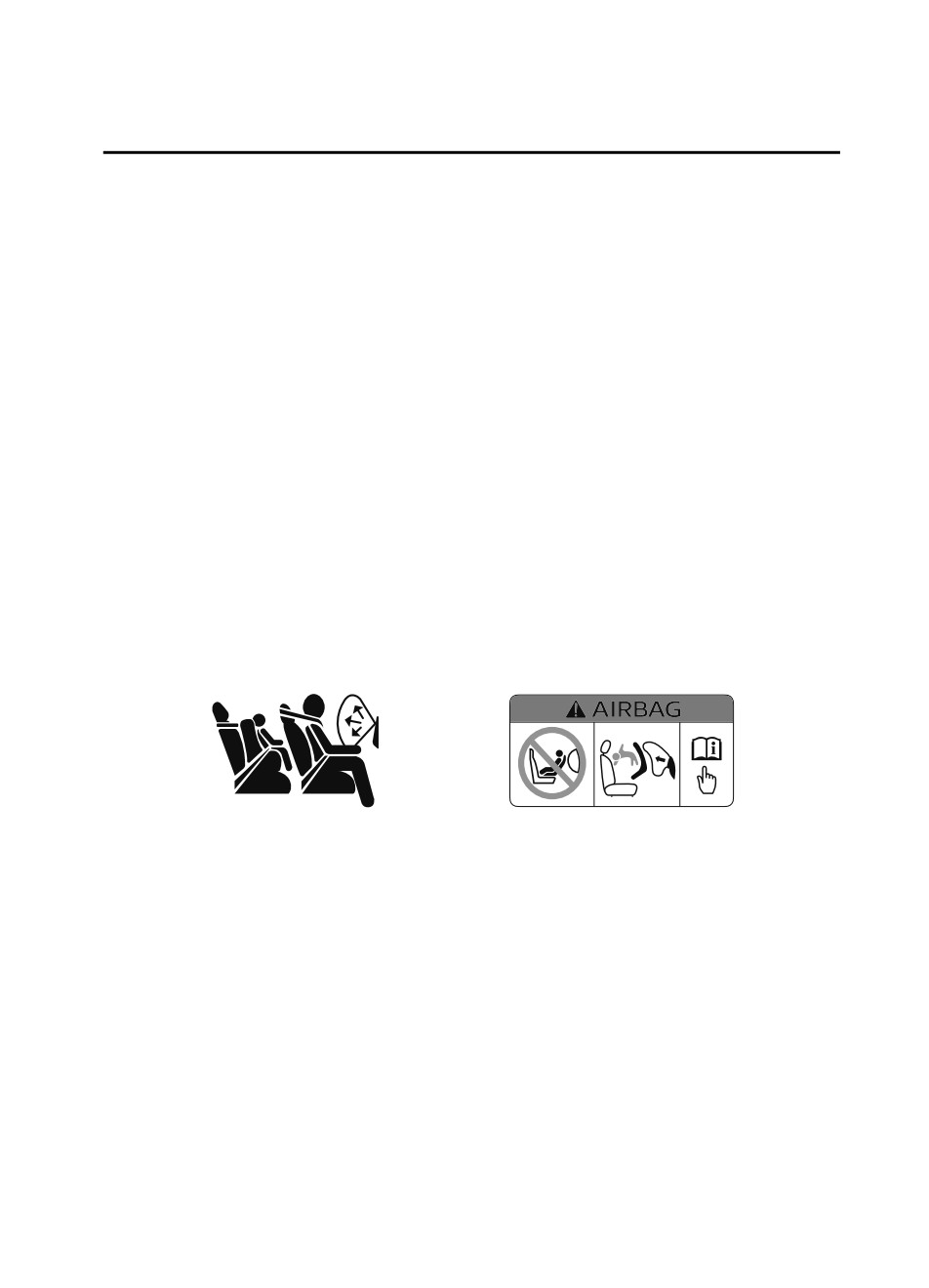
Essential Safety Equipment
SRS Air Bags
Properly dispose of the air bag system:
Improper disposal of an air bag or a vehicle with live air bags in it can be extremely
dangerous. Unless all safety procedures are followed, injury could result. Have an Authorized
Mazda Dealer safely dispose of the air bag system or scrap an air bag equipped vehicle.
NOTE
If it becomes necessary to have the components or wiring system for the supplementary
restraint system modified to accommodate a person with certain medical conditions in
accordance with a certified physician, contact an Authorized Mazda Dealer, refer to
“Customer Assistance (U.S.A.)” (page 8-2).
When an air bag deploys, a loud inflation noise can be heard and some smoke will be
released. Neither is likely to cause injury, however, the texture of the air bags may cause
light skin injuries on body parts not covered with clothing through friction.
Should you sell your Mazda, we urge you to tell the new owner of its air bag systems and
that familiarization with all instructions about them, from the Owner's Manual, is
important.
This highly-visible label is displayed which warns against the use of a rear-facing
child-restraint system on the front passenger seat.
(Except Mexico)
(Mexico)
2-75
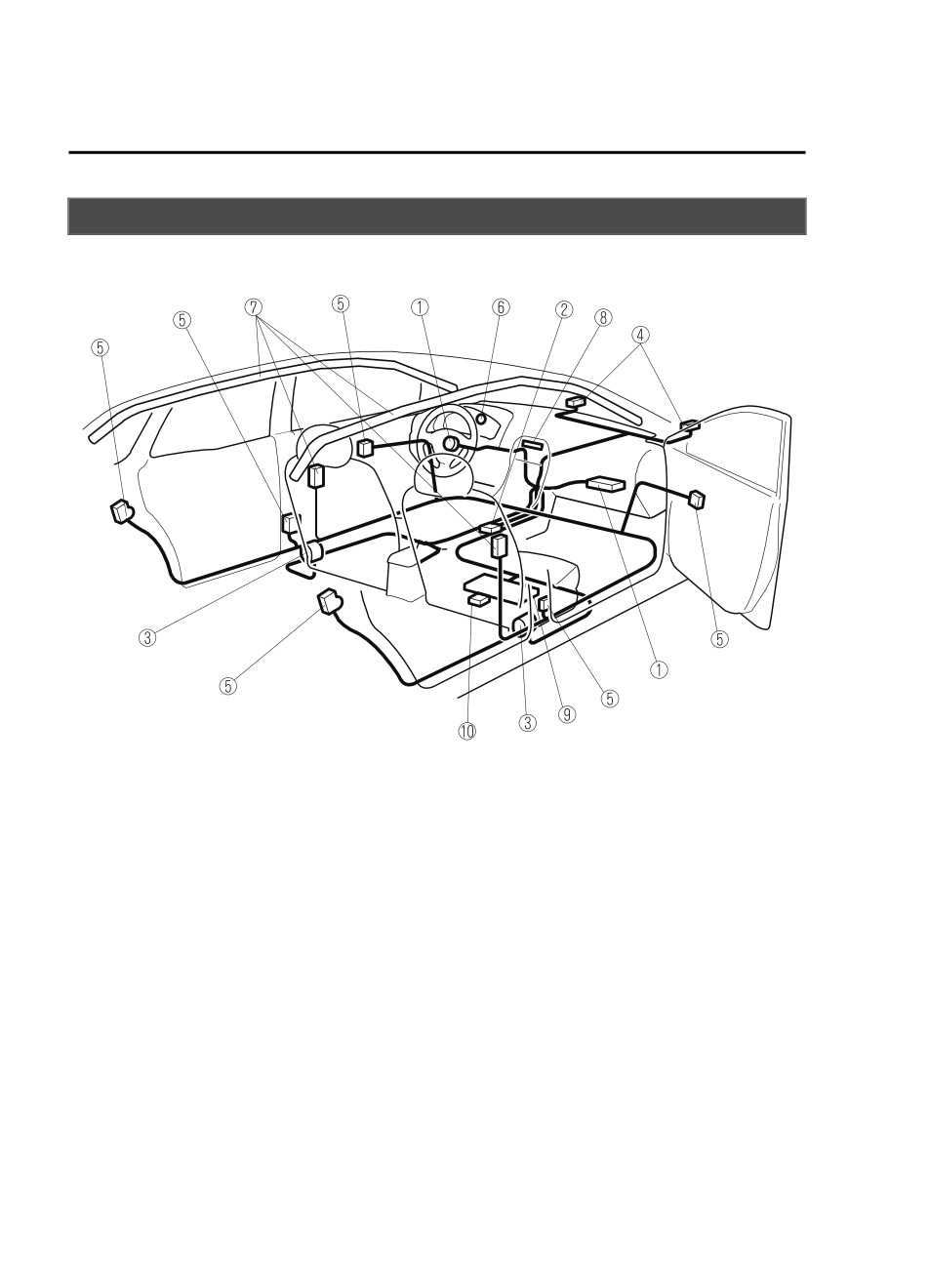
Essential Safety Equipment
SRS Air Bags
Supplemental Restraint System Components
(With Front Passenger Occupant Classification System)
2-76

Essential Safety Equipment
SRS Air Bags
(Without Front Passenger Occupant Classification System)
Driver/Front passenger inflators and air bags
Roll-over sensor*, crash sensors, and diagnostic module (SAS unit)
Front seat belt pretensioners (page 2-40)
Front air bag sensors
Side crash sensors
Air bag/front seat belt pretensioner system warning light (page 7-31)
Side and curtain inflators and air bags
Front passenger air bag deactivation indicator light* (page 2-85)
Front passenger occupant classification sensor* (page 2-85)
Front passenger occupant classification module*
*Some models.
2-77
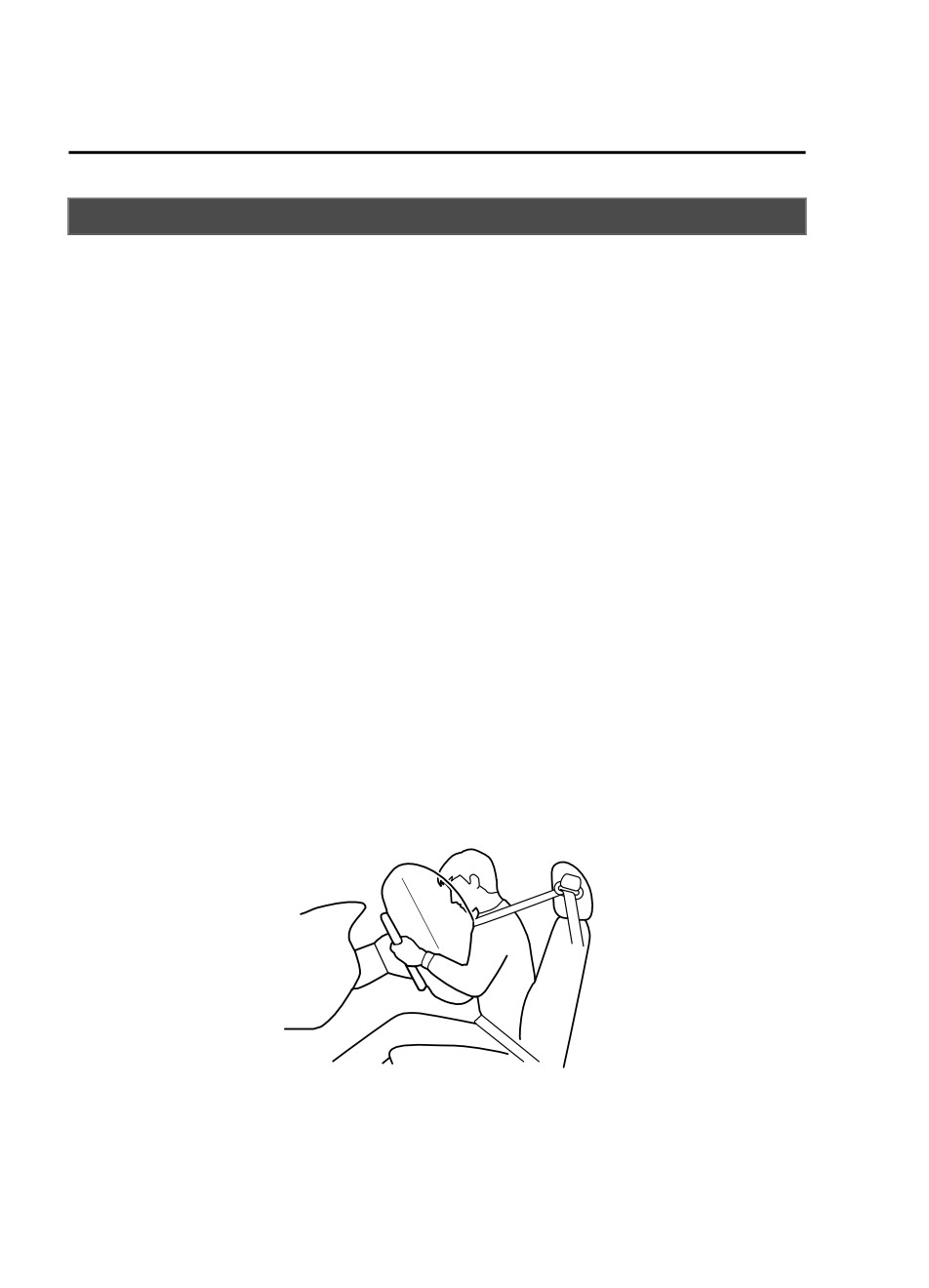
Essential Safety Equipment
SRS Air Bags
How the SRS Air Bags Work
Your Mazda is equipped with the following types of SRS air bags. SRS air bags are
designed to work together with the seat belts to help to reduce injuries during an accident.
The SRS air bags are designed to provide further protection for passengers in addition to the
seat belt functions. Be sure to wear seat belts properly.
▼ Front Seat Belt Pretensioners
The front seat belt pretensioners are designed to deploy in moderate or severe frontal, near
frontal collisions.
In addition, the pretensioners operate when a side collision or a roll-over accident is
detected. The pretensioners operate differently depending on what types of air bags are
equipped. For more details about seat belt pretensioner operation, refer to the SRS Air Bag
Deployment Criteria (page 2-82).
▼ Driver Air Bag
The driver's air bag is mounted in the steering wheel.
When air bag crash sensors detect a frontal impact of greater than moderate force, the
driver's air bag inflates quickly helping to reduce injury mainly to the driver's head or chest
caused by directly hitting the steering wheel.
For more details about air bag deployment, refer to "SRS Air Bag Deployment Criteria"
(page 2-82).
(With Front Passenger Occupant Classification System)
The driver's dual-stage air bag controls air bag inflation in two energy stages. During an
impact of moderate severity, the driver's air bag deploys with lesser energy, whereas during
more severe impacts, it deploys with more energy.
2-78
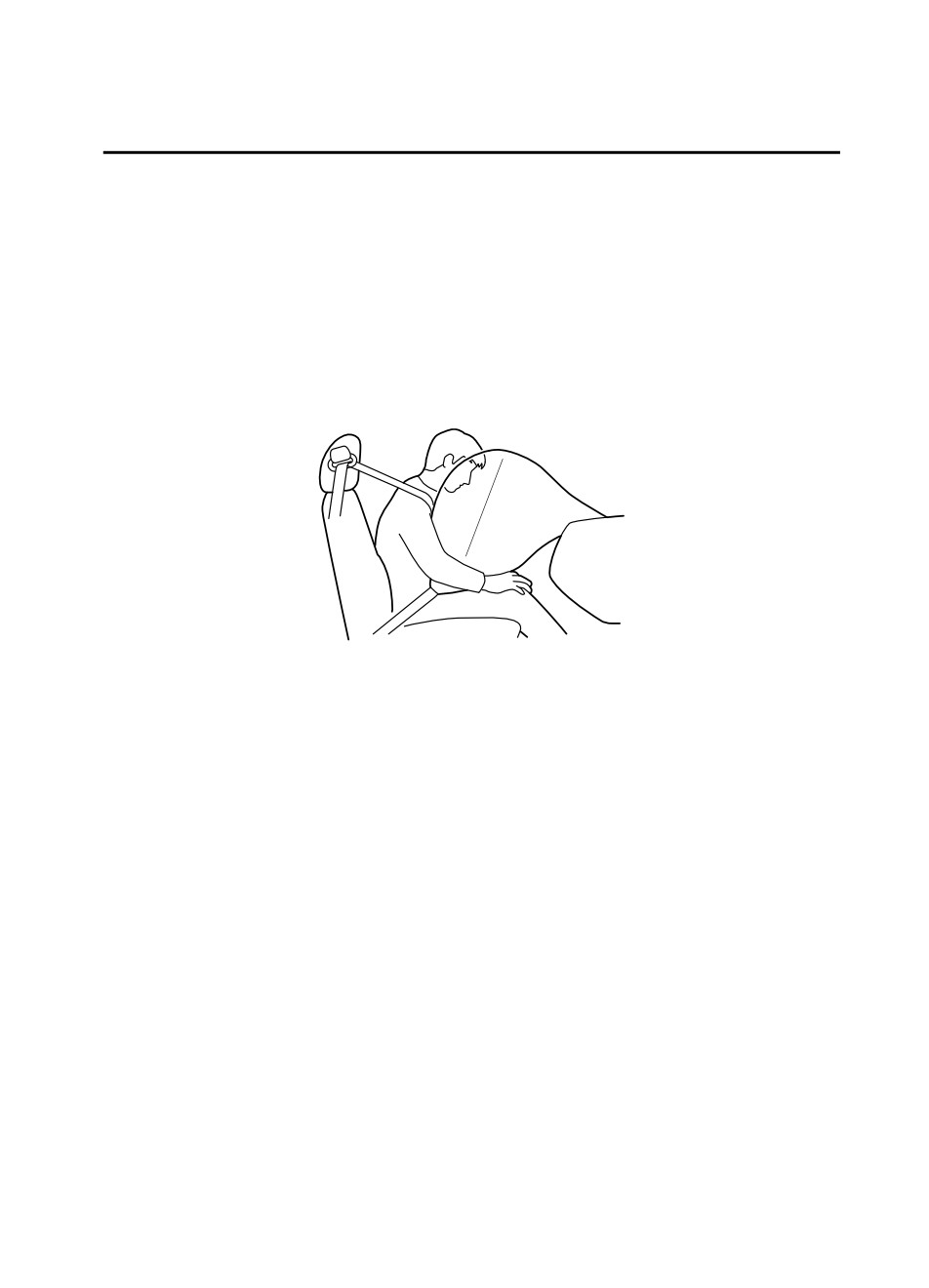
Essential Safety Equipment
SRS Air Bags
▼ Front Passenger Air Bag
The front passenger air bag is mounted in the front passenger dashboard.
The inflation mechanism for the front passenger air bag is the same as the driver's air bag.
For more details about air bag deployment, refer to "SRS Air Bag Deployment Criteria"
(page 2-82).
(With Front Passenger Occupant Classification System)
In addition, the front passenger air bag is designed to only deploy when the front passenger
occupant classification sensor detects a passenger sitting on the front passenger's seat. For
details, refer to the front passenger occupant classification system (page 2-85).
▼ Side Air Bags
The side air bags are mounted in the outboard sides of the front seatbacks.
When the air bag crash sensors detect a side impact of greater than moderate force, the
system inflates the side air bag only on the side in which the vehicle was hit. The side air
bag inflates quickly to reduce injury to the driver or front passenger's chest caused by
directly hitting interior parts such as a door or window.
For more details about air bag deployment, refer to "SRS Air Bag Deployment Criteria"
(page 2-82).
2-79
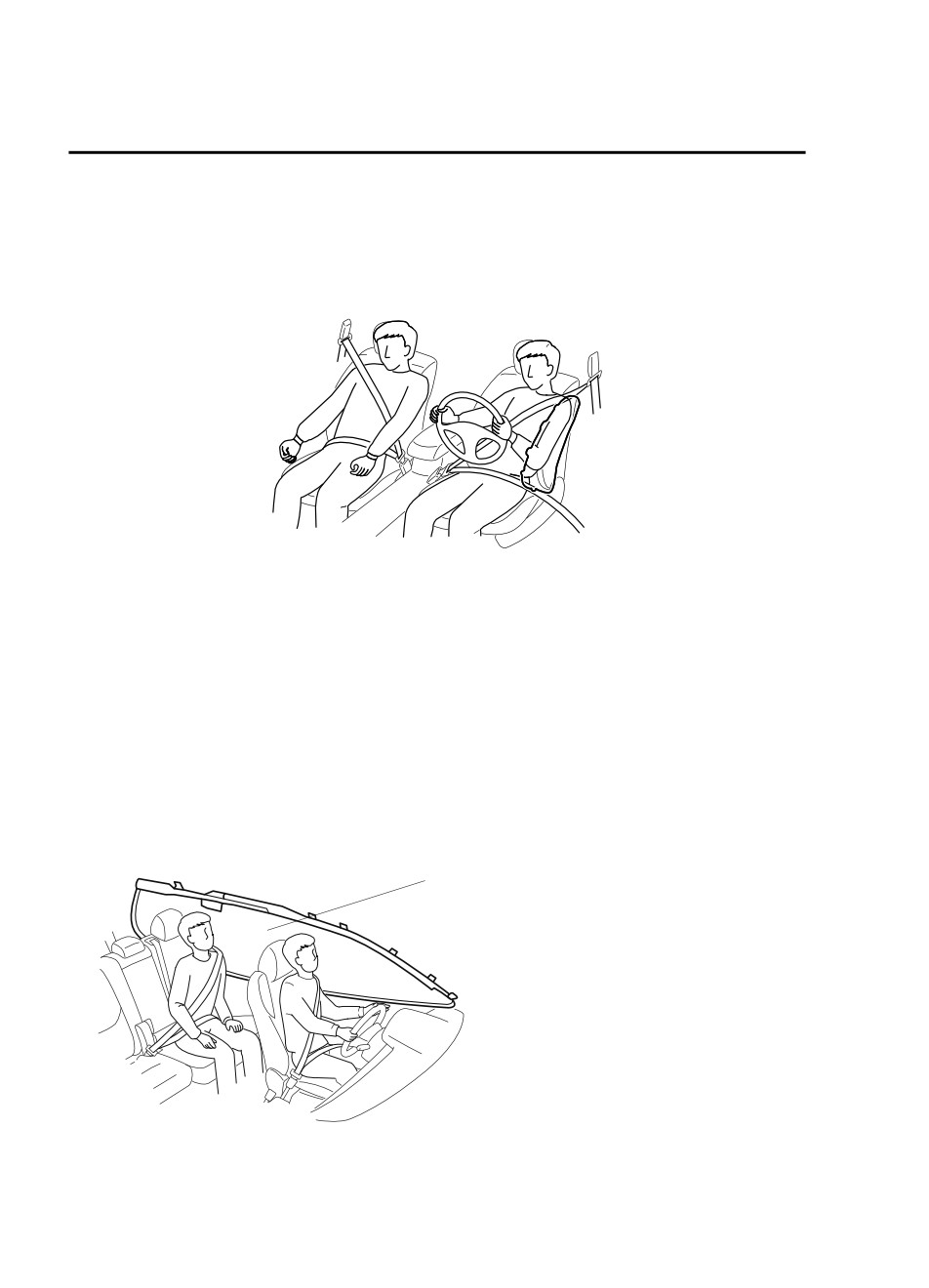
Essential Safety Equipment
SRS Air Bags
(With Front Passenger Occupant Classification System)
In addition, the front passenger side air bag is designed to only deploy when the front
passenger occupant classification sensor detects a passenger sitting on the front passenger's
seat. For details, refer to the front passenger occupant classification system (page 2-85).
▼ Curtain Air Bags
The curtain air bags are mounted in the front and rear window pillars, and the roof edge
along both sides.
When the air bag crash sensors detect a side impact of greater than moderate force, the
curtain air bag inflates quickly and helps to reduce injury mainly to the rear outboard
passenger's head caused by directly hitting interior parts such as a door or window.
For more details about air bag deployment, refer to "SRS Air Bag Deployment Criteria"
(page 2-82).
In a side impact:
Greater than moderate impact to one side of the vehicle will cause the curtain air bag on that
side only to inflate.
Only one side curtain air bag will deploy on the
side of the vehicle that receives the force of an
impact.
2-80
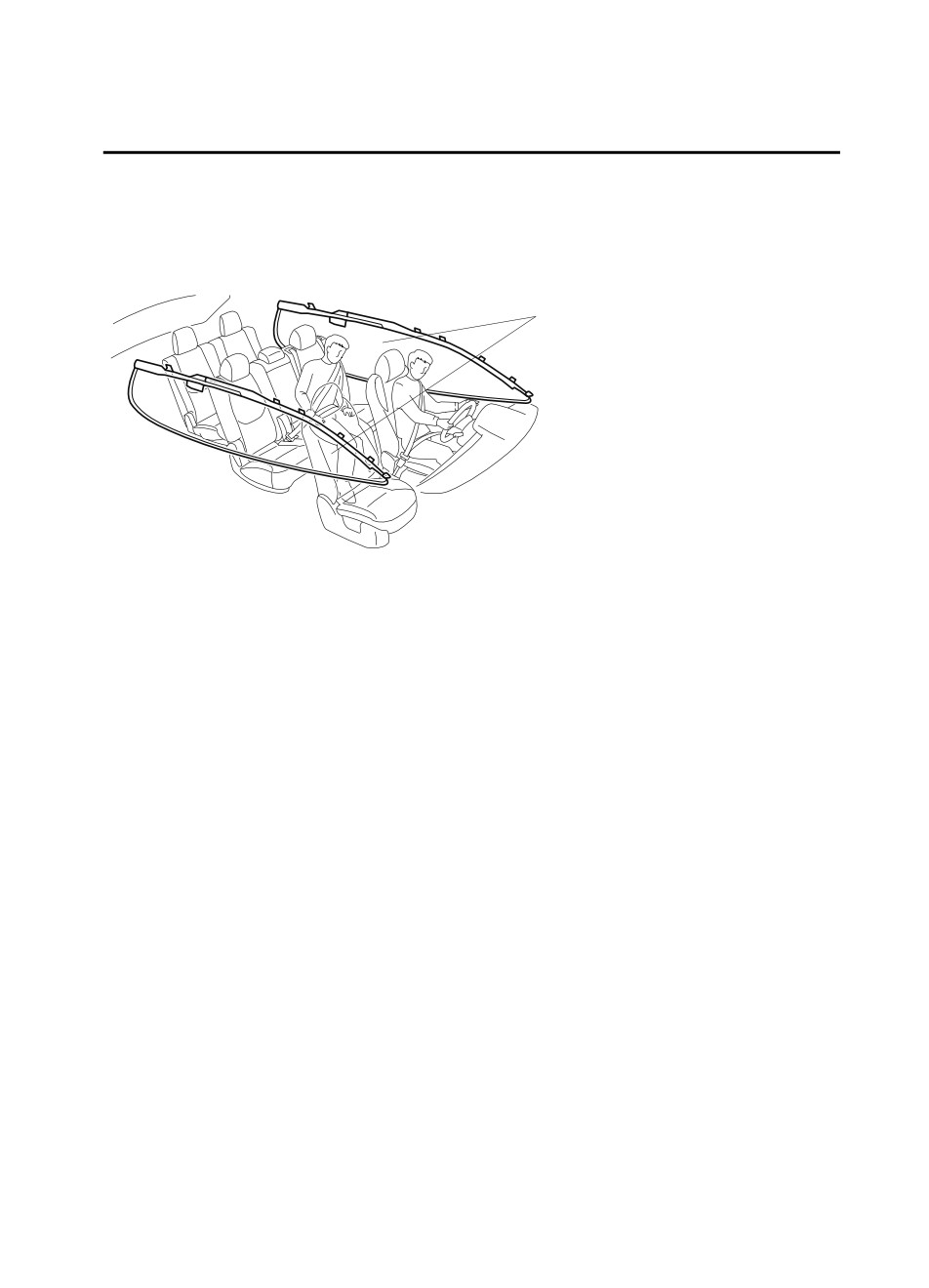
Essential Safety Equipment
SRS Air Bags
(With Front Passenger Occupant Classification System)
In a roll-over:
In response to a vehicle roll-over, both curtain air bags inflate.
Both curtain air bags will deploy after
the roll-over accident is detected.
▼ Warning Light/Beep
A system malfunction or operation conditions are indicated by a warning.
Refer to Contact an Authorized Mazda Dealer and Have Vehicle Inspected on page 7-31.
Refer to Warning Sound is Activated on page 7-45.
2-81

Essential Safety Equipment
SRS Air Bags
SRS Air Bag Deployment Criteria
This chart indicates the applicable SRS equipment that will deploy depending on the type of
collision.
(The illustrations are the representative cases of collisions.)
Types of collision
A severe frontal/near frontal colli-
A severe side colli-
A roll-over/near
A rear collision
sion
sion*2
roll-over*3
SRS equip-
ment
Front seat
belt preten-
X*1
X*1
X*1
sioner
Driver air
X
bag
No air bag and
front seat belt pre-
Front pas-
tensioner will be
senger air
X*1
activated in a rear
bag
collision.
X*1 (impact side
Side air bag
only)
Curtain air
X (impact side on-
X (both sides)
bag
ly)
X: The SRS air bag equipment is designed to deploy in a collision.
*1
(With Front Passenger Occupant Classification System)
The front passenger front and side air bags and the seat belt pretensioner are designed to deploy when the front
passenger occupant classification sensor detects a passenger sitting on the front passenger's seat.
*2
In a side collision, the seat belt pretensioners and the side/curtain air bags deploy.
*3
(With Front Passenger Occupant Classification System)
In a roll-over accident, the seat belt pretensioners and the curtain air bags deploy.
NOTE
In a frontal offset collision, the equipped air bags and pretensioners may all deploy
depending on the direction, angle, and rate of impact.
2-82
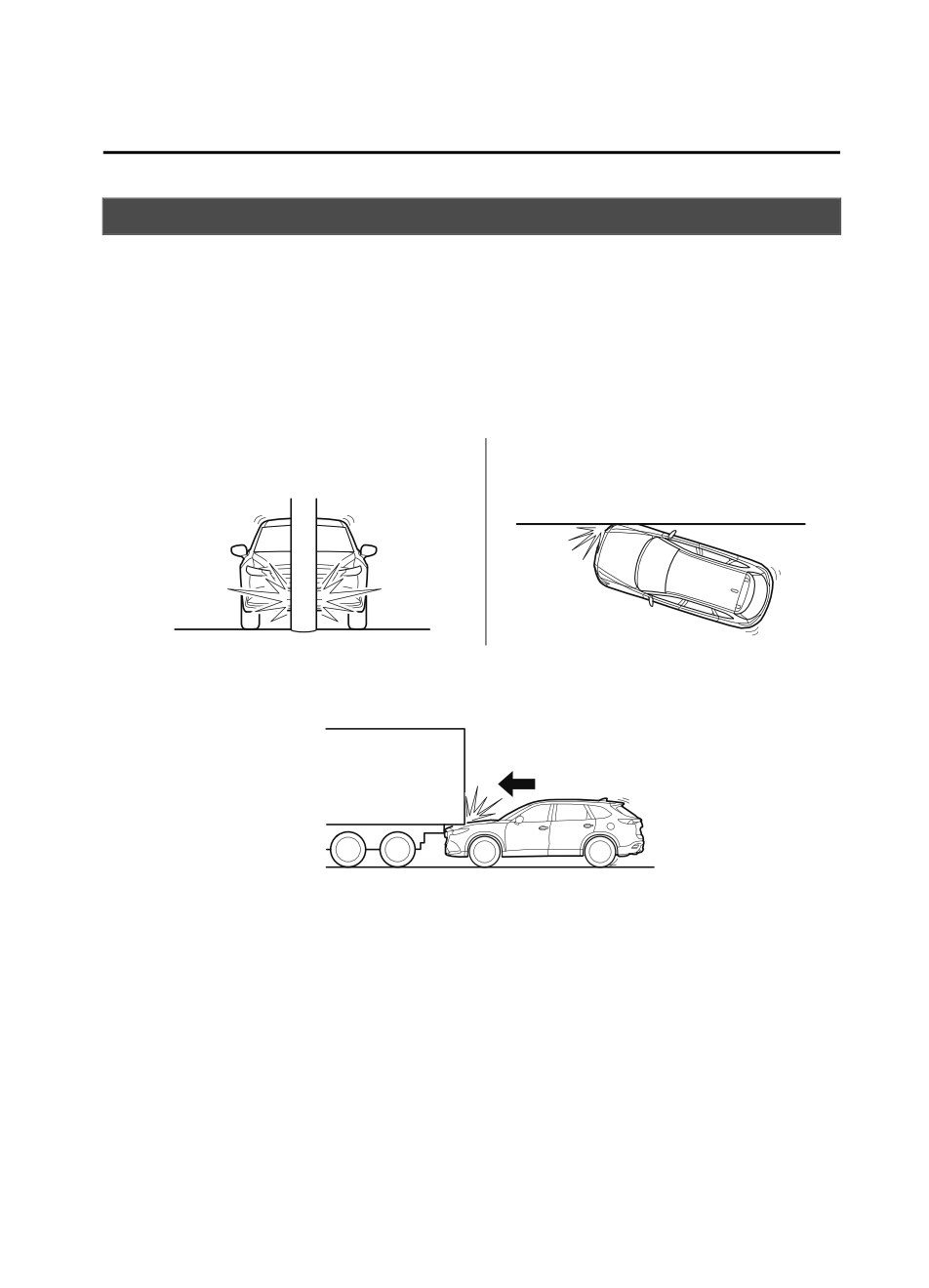
Essential Safety Equipment
SRS Air Bags
Limitations to SRS Air Bag
In severe collisions such as those described previously in "SRS Air Bag Deployment
Criteria", the applicable SRS air bag equipment will deploy. However, in some accidents,
the equipment may not deploy depending on the type of collision and its severity.
Limitations to front/near front collision detection:
The following illustrations are examples of front/near front collisions that may not be
detected as severe enough to deploy the SRS air bag equipment.
Impacts involving trees or poles
Frontal offset impact to the vehicle
Rear-ending or running under a truck's tail gate
2-83
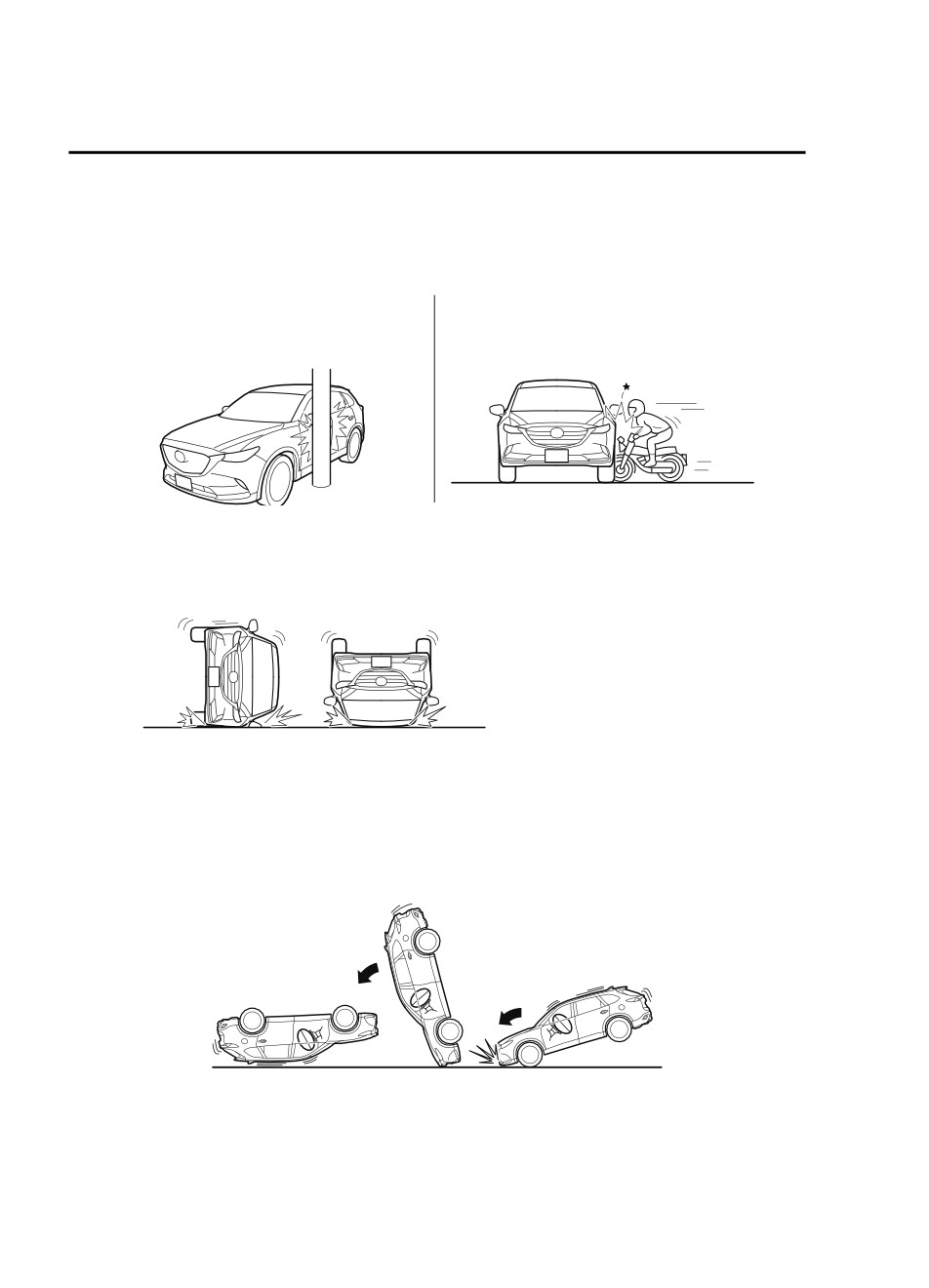
Essential Safety Equipment
SRS Air Bags
Limitations to side collision detection:
The following illustrations are examples of side collisions that may not be detected as
severe enough to deploy the SRS air bag equipment.
Side impacts involving trees or poles
Side impacts with two-wheeled vehicles
Roll-over (Without Front Passenger Occupant Classification System)
(With Front Passenger Occupant Classification System)
Limitations to roll-over detection:
The following illustration is an example of an accident that may not be detected as a
roll-over accident. Therefore, the front seat belt pretensioners and curtain air bags may not
deploy.
Pitch end over end
2-84
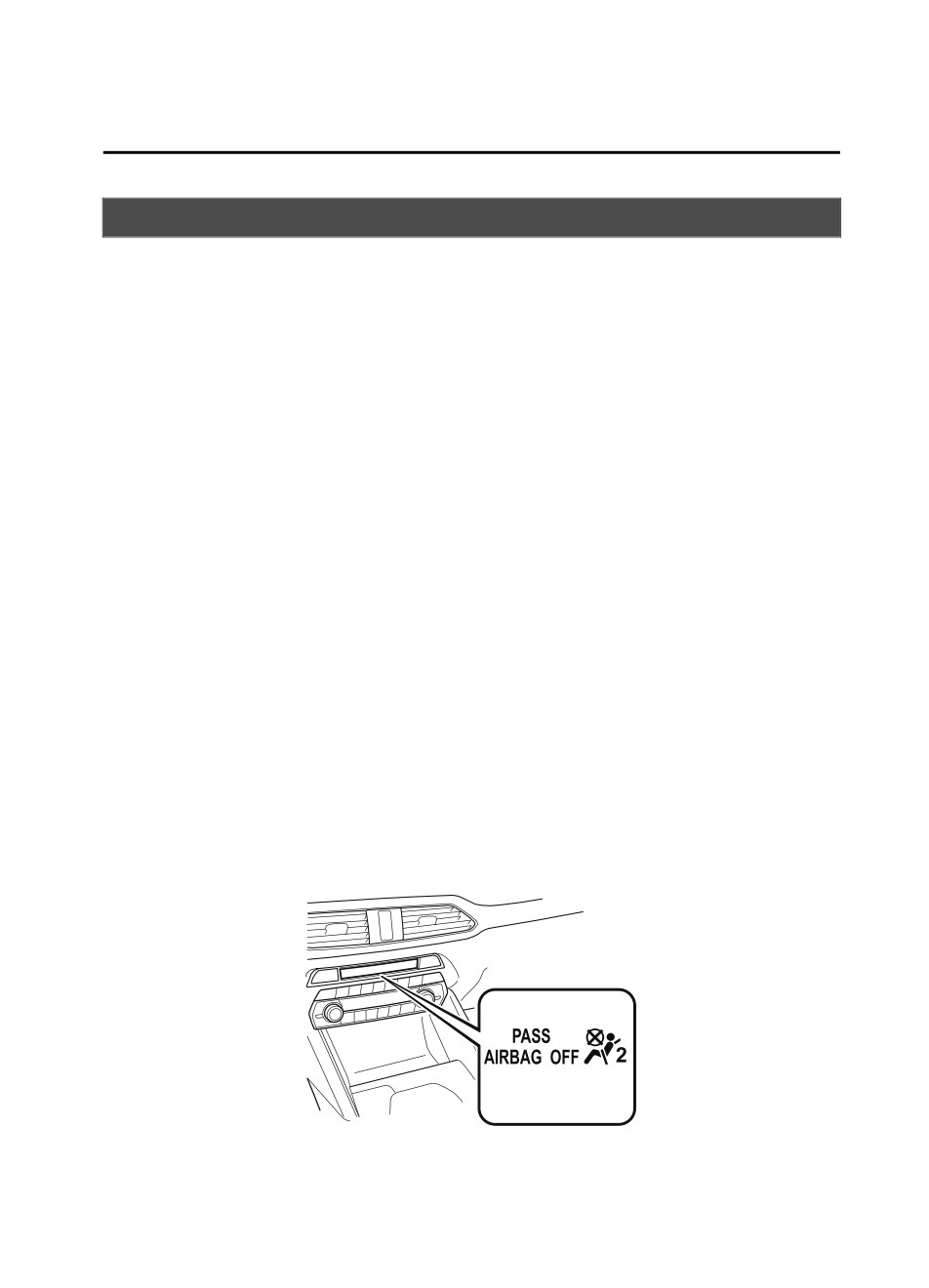
Essential Safety Equipment
SRS Air Bags
Front Passenger Occupant Classification System*
First, please read "Supplemental Restraint System (SRS) Precautions" (page 2-69) carefully.
▼ Front Passenger Occupant Classification Sensor
Your vehicle is equipped with a front passenger occupant classification sensor as a part of
the supplemental restraint system. This sensor is equipped in the front passenger's seat
cushion. This sensor measures the electrostatic capacity of the front passenger's seat. The
SAS unit is designed to prevent the front passenger front and side air bags and seat belt
pretensioner system from deploying if the front passenger air bag deactivation indicator
light turns on.
To reduce the chance of injuries caused by deployment of the front passenger air bag, the
system deactivates the front passenger front and side air bags and also the seat belt
pretensioner system when the front passenger air bag deactivation indicator light turns on.
Refer to the following table for the front passenger air bag deactivation indicator light
illumination conditions.
This system shuts off the front passenger front and side air bags and seat belt pretensioner
system, so make sure the front passenger air bag deactivation indicator light turns on
according to the following table.
The air bag/front seat belt pretensioner system warning light flashes and the front passenger
air bag deactivation indicator light illuminates if the sensors have a possible malfunction. If
this happens, the front passenger front and side air bags and seat belt pretensioner system
will not deploy.
Front passenger air bag deactivation indicator light
This indicator light turns on to remind you that the front passenger front and side air bags
and seat belt pretensioner will not deploy during a collision.
*Some models.
2-85
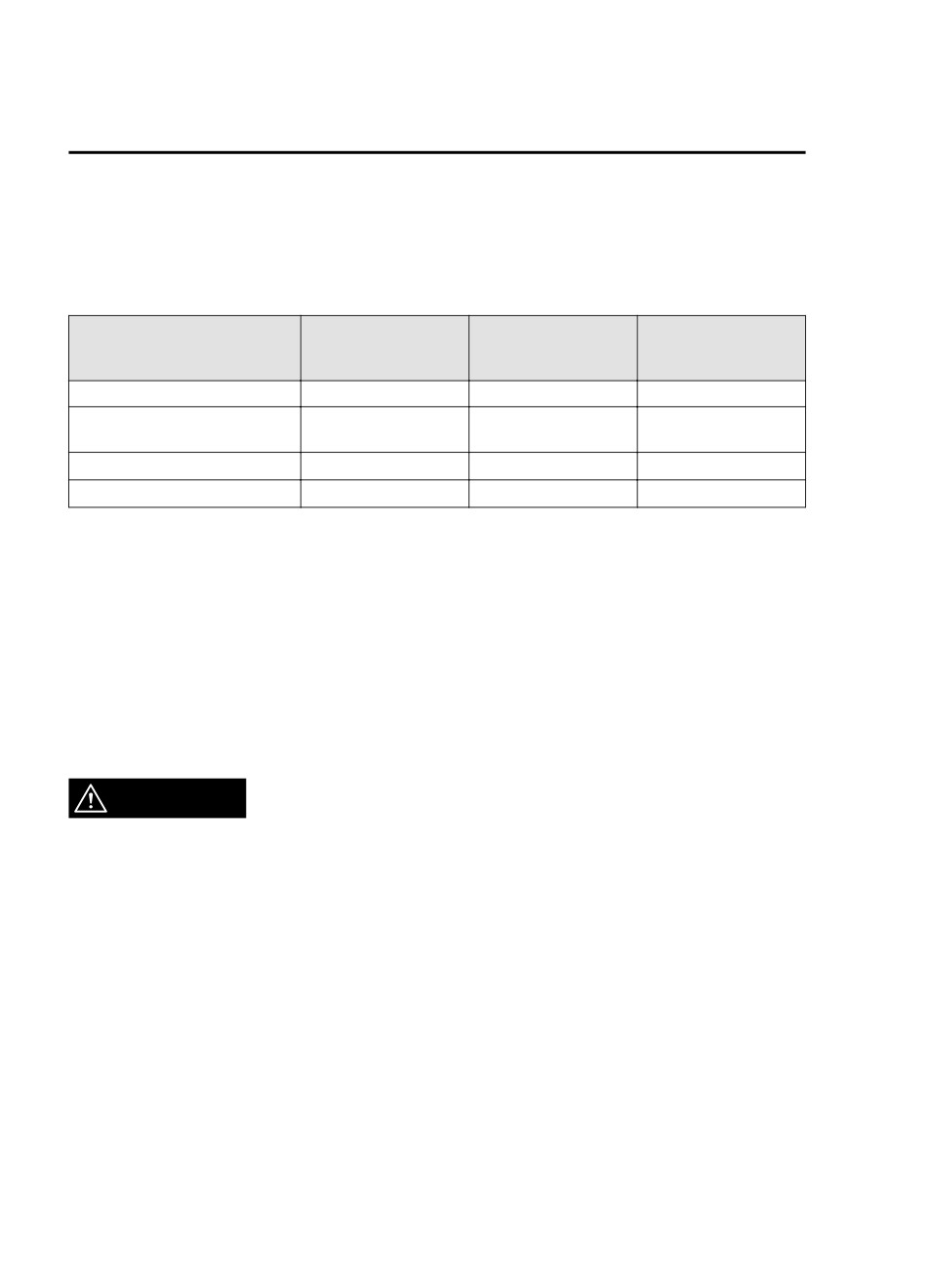
Essential Safety Equipment
SRS Air Bags
If the front passenger occupant classification sensor is normal, the indicator light turns on
when the ignition is switched ON. The light turns off after a few seconds. Then, the
indicator light turns on or is off under the following conditions:
Front passenger air bag deactivation indicator light on/off condition chart
Condition detected by the front
Front passenger air
Front passenger seat
Front passenger front
passenger occupant classifica-
bag deactivation indi-
belt pretensioner sys-
and side air bags
tion system
cator light
tem
Empty (Not occupied)
On
Deactivated
Deactivated
A child less than 1 year old is
On
Deactivated
Deactivated
seated in a child-restraint system
Child*1
On or off
Deactivated or ready
Deactivated or ready
Adult*2
Off
Ready
Ready
*1
The occupant classification sensor may not detect a child seated on the seat, in a child-restraint system, or a
junior seat depending on the child's physical size and seated posture.
*2
If a smaller adult sits on the front passenger seat, the sensors might detect the person as being a child
depending on the person's physique.
The curtain air bag is ready for inflating regardless of what the front passenger air bag
deactivation indicator light on/off condition chart indicates.
If the front passenger air bag deactivation indicator light does not turn on when the ignition
is switched ON and does not turn on as indicated in the front passenger air bag deactivation
indicator light on/off condition chart, do not allow an occupant to sit in the front passenger
seat and consult an Authorized Mazda Dealer as soon as possible. The system may not work
properly in an accident.
WARNING
Do not allow an occupant in the front passenger's seat to sit with a posture which makes it
difficult for the front passenger occupant classification sensor to detect the occupant
correctly:
Sitting in the front passenger's seat with a posture which makes it difficult for the front
passenger occupant classification sensor to detect the occupant correctly is dangerous. If the
front passenger occupant classification sensor cannot detect the occupant sitting on the front
passenger's seat correctly, the front passenger front and side air bags and pretensioner
system may not operate (non-deploy) or they may operate (deploy) accidentally. The front
passenger will not have the supplementary protection of the air bags or the accidental
operation (deployment) of the air bags could result in serious injury or death.
Under the following conditions, the front passenger occupant classification sensor cannot
detect a passenger sitting on the front passenger's seat correctly and the deployment/
non-deployment of the air bags cannot be controlled as indicated in the front passenger air
bag deactivation indicator light on/off condition chart. For example:
2-86

Essential Safety Equipment
SRS Air Bags
¾ A front passenger is seated as shown in the following figure:
¾ A rear passenger pushes up on the front passenger seat with their feet.
¾ Luggage or other items placed under the front passenger seat or between the front
passenger seat and driver seat that push up the front passenger seat bottom.
¾ An object, such as a seat cushion, is put on the front passenger's seat or between the
passenger's back and the seatback.
¾ A seat cover is put on the front passenger's seat.
¾ Luggage or other items are placed on the seat with the child in the child-restraint system.
¾ A rear passenger or luggage push or pull down on the front passenger seatback.
¾ Luggage or other items are placed on the seatback or hung on the head restraint.
¾ The seat is washed.
¾ Liquids are spilled on the seat.
¾ The front passenger seat is moved backward, pushing into luggage or other items placed
behind it.
¾ The front passenger seatback contacts the rear seat.
¾ Luggage or other items are placed between the front passenger seat and driver seat.
¾ An electric device is put on the front passenger's seat.
¾ An additional electrical device, such as a seat warmer is installed to the surface of the front
passenger seat.
2-87
Essential Safety Equipment
SRS Air Bags
The front passenger front and side air bags and seat belt pretensioner systems will deactivate
if the front passenger air bag deactivation indicator light turns on.
CAUTION
¾ To assure proper deployment of the front air bag and to prevent damage to the sensor in
the front seat cushion:
¾ Do not place sharp objects on the front seat cushion or leave heavy luggage on them.
¾ Do not spill any liquids on the front seats or under the front seats.
¾ To allow the sensors to function properly, always perform the following:
¾ Adjust the front seats as far back as possible and always sit upright against the seatbacks
with seat belts worn properly.
¾ If you place your child on the front passenger seat, secure the child-restraint system
properly and slide the front passenger seat as far back as possible (page 2-59).
NOTE
The system requires about 10 seconds to alternate between turning the front passenger
front and side air bags and seat belt pretensioner system on or off.
The front passenger air bag deactivation indicator light may turn on repeatedly if luggage
or other items are put on the front passenger seat, or if the temperature of the vehicle's
interior changes suddenly.
The front passenger air bag deactivation indicator light may turn on for 10 seconds if the
electrostatic capacity on the front passenger seat changes.
The air bag/front seat belt pretensioner system warning light might turn on if the front
passenger seat receives a severe impact.
If the front passenger air bag deactivation indicator light does not turn on after installing
a child-restraint system on the front passenger seat, first, re-install your child-restraint
system according to the procedure in this owner's manual. Then, if the front passenger air
bag deactivation indicator light still does not turn on, install the child-restraint system on
the rear seat and consult an Authorized Mazda Dealer as soon as possible.
If the front passenger air bag deactivation indicator light turns on when an occupant is
seated directly in the front passenger seat, have the passenger re-adjust their posture by
sitting with their feet on the floor, and then re-fastening the seat belt. If the front
passenger air bag deactivation indicator light remains turned on, move the passenger to
the rear seat. If sitting in the rear seat is not possible, slide the front passenger seat as far
back as possible. Consult an Authorized Mazda Dealer as soon as possible.
2-88
Essential Safety Equipment
SRS Air Bags
Constant Monitoring
The following components of the air bag systems are monitored by a diagnostic system:
Front air bag sensors
Crash sensors, and diagnostic module (SAS unit)
Side crash sensors
Air bag modules
Front seat belt pretensioners
Air bag/Front seat belt pretensioner system warning light
Related wiring
(With Front Passenger Occupant Classification System)
Front passenger occupant classification sensor
Front passenger occupant classification module
Front passenger air bag deactivation indicator light
The diagnostic module continuously monitors the system's readiness. This begins when the
ignition is switched ON and continues while the vehicle is being driven.
2-89
Before Driving
3
Use of various features, including keys, doors, mirrors and windows.
Keys
3-2
Security System
3-43
Keys
3-2
Modification and Add-On
Keyless Entry System
3-4
Equipment
3-43
Immobilizer System
3-43
Theft-Deterrent System*
3-45
Advanced Keyless Entry
System
3-10
Advanced Keyless Entry System*
Driving Tips
3-47
. . . . . . . . . . . . . 3-10
Break-In Period
3-47
Operational Range
3-11
Saving Fuel and Protection of the
Environment
3-47
Hazardous Driving
3-48
Doors and Locks
3-12
Floor Mat
3-49
Door Locks
3-12
Rocking the Vehicle
3-49
Liftgate
3-18
Winter Driving
3-50
Driving In Flooded Area
3-52
Fuel and Emission
3-27
Overloading
3-52
Fuel and Engine Exhaust
Driving on Uneven Road
3-53
Precautions
3-27
Turbocharger Information
3-54
Fuel-Filler Lid and Cap
3-30
Towing
3-55
Mirrors
3-32
Trailer Towing (U.S.A. and
Mirrors
3-32
Canada)
3-55
Recreational Towing
3-63
Windows
3-37
Power Windows
3-37
Moonroof*
3-40
*Some models.
3-1
Большое спасибо!
Ваше мнение очень важно для нас.

Нет комментариевНе стесняйтесь поделиться с нами вашим ценным мнением.
Текст